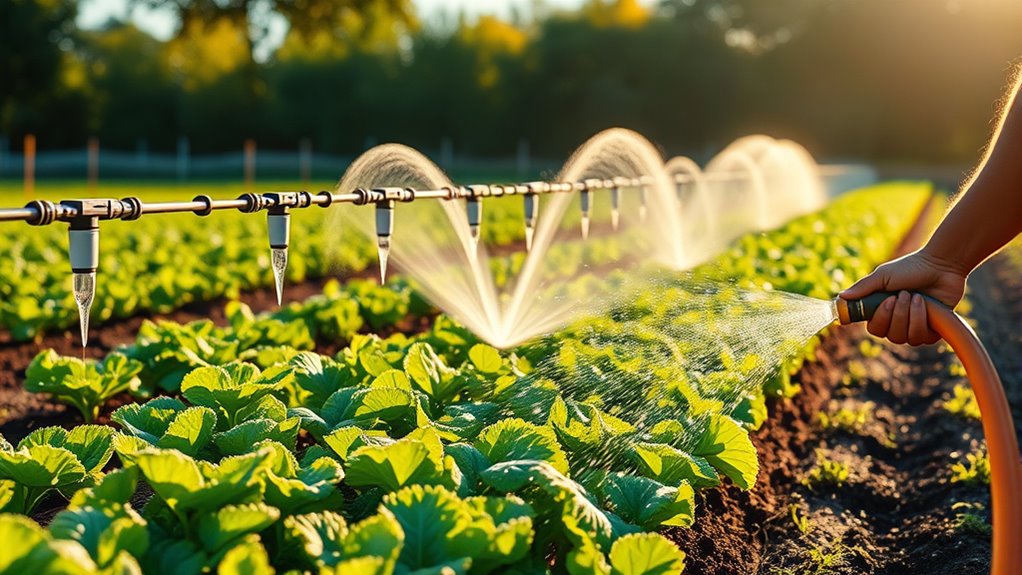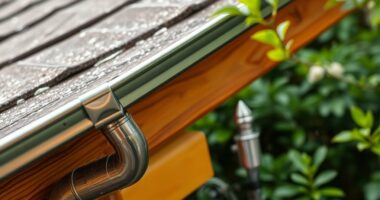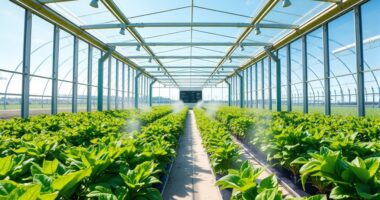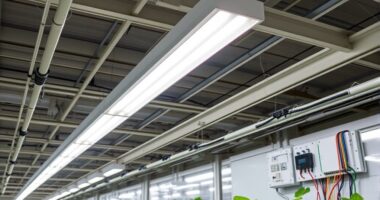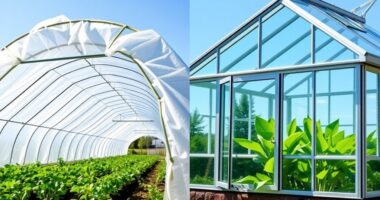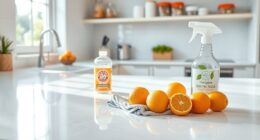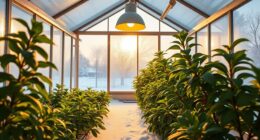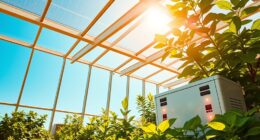To choose between drip, sprinkler, or hand-watering, consider your garden’s size, plant types, and water efficiency goals. Drip systems work well for targeted watering at plant roots, saving water and preventing runoff. Sprinklers cover large areas but require proper placement and scheduling. Hand-watering offers maximum control for specific plants but can be labor-intensive. Understanding your garden’s specific needs helps you pick the best system—continue to explore for expert tips and strategies.
Key Takeaways
- Consider garden size, plant types, and water efficiency goals to choose the most suitable irrigation method.
- Drip systems are ideal for targeted watering and water conservation, especially with soil moisture sensors.
- Sprinklers provide uniform coverage for lawns but require proper placement and scheduling to minimize waste.
- Hand-watering offers maximum control and is effective for small or specific areas needing precise attention.
- Integrating sensors and smart controllers enhances irrigation efficiency, reduces water waste, and promotes healthy plants.
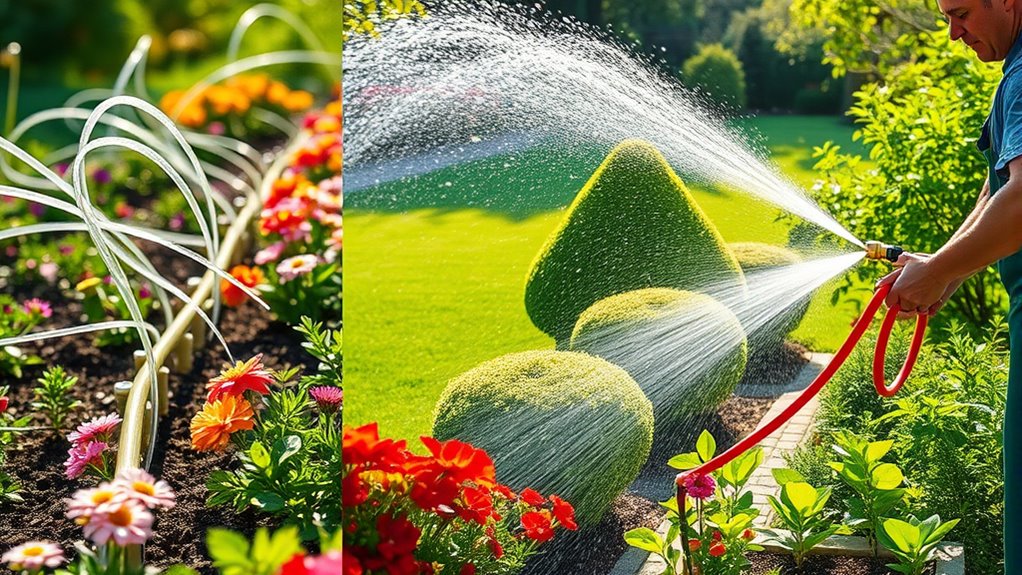
Are you unsure which irrigation system best suits your needs? Choosing the right method depends on your garden size, plant types, and your goals for water efficiency. One of the most effective ways to make an informed decision is by understanding how soil moisture sensors can help. These devices measure the moisture level in the soil, giving you real-time data that guides when and how much to water. Using soil moisture sensors is a smart water conservation technique because they prevent overwatering, which not only saves water but also promotes healthier plants. If you’re aiming to reduce waste and cut down on water bills, integrating sensors into your irrigation plan can make a significant difference.
When it comes to irrigation options, drip systems are excellent for targeted watering. They deliver water directly to the roots of your plants through a network of tubes and emitters. This method minimizes evaporation and runoff, making it highly efficient—especially when combined with soil moisture sensors. By monitoring soil moisture levels, you can fine-tune your drip system to provide just the right amount of water, avoiding excess that can lead to fungal issues or wasted resources. Drip irrigation is ideal for flower beds, vegetable gardens, and container plants, where precision watering matters most. Plus, it’s a water conservation technique that conserves water by reducing unnecessary runoff and evaporation, ensuring your plants get what they need without waste.
Sprinkler systems are a popular choice for lawns and larger areas, offering uniform coverage with less manual effort. Modern sprinklers can be programmed to run at specific times, and some models now incorporate smart technology, including soil moisture sensors. These sensors can trigger the sprinklers to turn on only when the soil is dry enough, preventing overwatering. This smart integration makes sprinklers more efficient and aligns with water conservation techniques. However, keep in mind that traditional sprinklers tend to lose more water through evaporation and runoff compared to drip systems. Proper placement and scheduling are key to maximizing efficiency, especially if you’re concerned about water waste. Additionally, smart irrigation controllers can further optimize watering schedules based on weather conditions and soil moisture data, making the system even more efficient.
Hand-watering gives you the most control, letting you adjust your approach based on visual cues and soil conditions. While it may seem labor-intensive, hand-watering allows you to target specific plants or areas that need extra attention. If you’re serious about water conservation, pairing hand-watering with soil moisture sensors can help you determine exactly when and where to water, avoiding unnecessary watering and promoting healthy growth. This method also lets you observe your plants closely, catching problems early and adjusting your watering habits accordingly.
Ultimately, selecting the right irrigation system hinges on understanding your garden’s needs and leveraging tools like soil moisture sensors to optimize water use. Whether you opt for drip, sprinklers, or hand-watering, integrating water conservation techniques ensures you’re watering smartly, saving resources, and keeping your plants thriving.
Frequently Asked Questions
Which Irrigation System Is Most Eco-Friendly?
You’ll find that drip irrigation is the most eco-friendly option, especially when combined with rainwater harvesting and soil moisture sensors. These tools help you conserve water by delivering it directly to plant roots and avoiding runoff. Sprinklers waste more water through evaporation and overspray, while hand-watering can be inefficient. Embracing drip systems with rainwater harvesting and soil moisture sensors minimizes water use, benefiting the environment and your garden.
How Do Costs Compare Over the Long Term?
Your cost analysis shows drip irrigation often has the lowest long-term costs due to its water efficiency and minimal maintenance needs. Sprinklers might cost more initially but can lead to higher water bills, decreasing long-term savings. Hand-watering is cheapest upfront but becomes labor-intensive and costly over time. By considering these factors, you’ll find drip systems usually provide the best long-term savings, making them a smart investment.
Can Existing Systems Be Upgraded Easily?
Yes, existing systems can often be upgraded easily, but it depends on system compatibility and installation complexity. You should assess whether new components fit your current setup, like adding drip lines to sprinkler zones or upgrading controllers. If your system is outdated or poorly designed, upgrading might require significant work. Consulting a professional can help you determine the best options for a seamless upgrade that improves efficiency and longevity.
What Maintenance Is Required for Each System?
You’ll need to regularly check each system’s durability by inspecting for leaks or clogs. Drip systems require cleaning filters and checking emitters, while sprinklers need nozzle adjustments and valve inspections. Hand-watering involves less equipment but still demands routine cleaning of hoses. Troubleshooting techniques include identifying clogged emitters or uneven watering patterns. Consistent maintenance helps keep your system effective, reduces repairs, and ensures healthy plants.
How Do Weather Conditions Affect System Choice?
Like a trusty knight in shining armor, your irrigation choice depends on weather patterns and seasonal adjustments. If you face frequent rain, sprinklers might waste water, so switch to drip systems for efficiency. Hot, dry weather calls for more frequent watering, favoring automated sprinklers or hand-watering. Understanding how weather influences your system helps you save water and keep your garden thriving through every seasonal shift.
Conclusion
Now that you’ve explored drip, sprinkler, and hand-watering options, you’re ready to choose the best system for your garden. Remember, the grass isn’t always greener on the other side, so pick what suits your needs and resources best. With the right irrigation, your plants will thrive, and you’ll save time and water along the way. Trust your instincts, and don’t be afraid to adapt as you learn what works best. Your garden will thank you!
